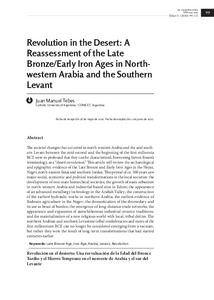Por favor, use este identificador para citar o enlazar este ítem:
https://repositorio.uca.edu.ar/handle/123456789/10897| Título: | Revolution in the desert : a reassessment of the late bronze/early iron ages in northwestern Arabia and the southern levant Revolución en el desierto : Una reevaluación de la Edad del Bronce Tardío y el Hierro Temprano en el noroeste de Arabia y el sur del Levante |
Autor: | Tebes, Juan Manuel | Palabras clave: | EDAD DE BRONCE; EDAD DE HIERRO; REVOLUCION; HISTORIA ANTIGUA; ANTIGUO ORIENTE; SOCIEDAD | Fecha de publicación: | 2020 | Editorial: | Instituto de Historia Antigua Oriental Dr. Abraham Rosenvasser | Cita: | Tebes, J. M. Revolution in the Desert : A Reassessment of the Late Bronze/Early Iron Ages in Northwestern Arabia and the Southern Levant [en línea] Rihao 2020, 99 (125). Doi: 10.34096/rihao.n21.8653. Disponible en: https://repositorio.uca.edu.ar/handle/123456789/10897 | Resumen: | Abstract: The societal changes that occurred in north-western Arabia and the arid southern
Levant between the mid-second and the beginning of the first millennia
BCE were so profound that they can be characterized, borrowing Steven Rosen’s
terminology, as a “desert revolution.” This article will review the archaeological
and epigraphic evidence of the Late Bronze and Early Iron Ages in the Hejaz,
Negev, north-eastern Sinai and southern Jordan. This period of ca. 500 years saw
major social, economic and political transformations in the local societies: the
development of non-state hierarchical societies; the growth of oasis urbanism
in north-western Arabia and industrial-based sites in Edom; the appearance
of an advanced metallurgy technology in the Arabah Valley; the construction
of the earliest hydraulic works in northern Arabia; the earliest evidence of
Bedouin agriculture in the Negev; the domestication of the dromedary and
its use as beast of burden; the emergence of long-distance trade networks; the
appearance and expansion of autochthonous industrial ceramic traditions;
and the materialization of a new religious world with local, tribal deities. Resumen: Los cambios sociales que se produjeron en el noroeste de Arabia y en el sur del Levante árido entre mediados del segundo y principios del primer milenio a.n.e. fueron tan profundos que pueden caracterizarse, tomando prestada la terminología de Steven Rosen, como una “revolución en el desierto”. Este artículo explorará las evidencias arqueológicas y epigráficas de la Edad del Bronce Tardío y de la Edad del Hierro Temprano en el Hejaz, el Negev, el noreste del Sinaí y el sur de Jordania. Este período de ca. 500 años vio grandes transformaciones sociales, económicas y políticas en las sociedades locales: el desarrollo de sociedades jerárquicas no estatales; la emergencia del urbanismo de oasis en el noroeste de Arabia y de sitios industriales en Edom; la aparición de una tecnología metalúrgica de avanzada en el Valle de Arabá; la construcción de las primeras obras hidráulicas en el norte de Arabia; las evidencias más antiguas de agricultura beduina en el Negev; la domesticación del dromedario y su utilización como animal de carga; la aparición de redes de comercio de larga distancia; la aparición y expansión de tradiciones de cerámica industrial autóctona; y la materialización de un nuevo mundo religioso con deidades tribales locales. |
URI: | https://repositorio.uca.edu.ar/handle/123456789/10897 | ISSN: | 0325-1209 | Disciplina: | HISTORIA | DOI: | 10.34096/rihao.n21.8653 | Derechos: | Acceso abierto | Fuente: | Revista del Instituto de Historia Antigua Oriental Nro. 99 (125), 2020 |
| Aparece en las colecciones: | Artículos |
Ficheros en este ítem:
| Fichero | Descripción | Tamaño | Formato | |
|---|---|---|---|---|
| revolution-desert-reassessment.pdf | 821,85 kB | Adobe PDF |  Visualizar/Abrir |
Visualizaciones de página(s)
146
comprobado en 30-abr-2024
Descarga(s)
535
comprobado en 30-abr-2024
Google ScholarTM
Ver en Google Scholar
Altmetric
Altmetric
Este ítem está sujeto a una Licencia Creative Commons

